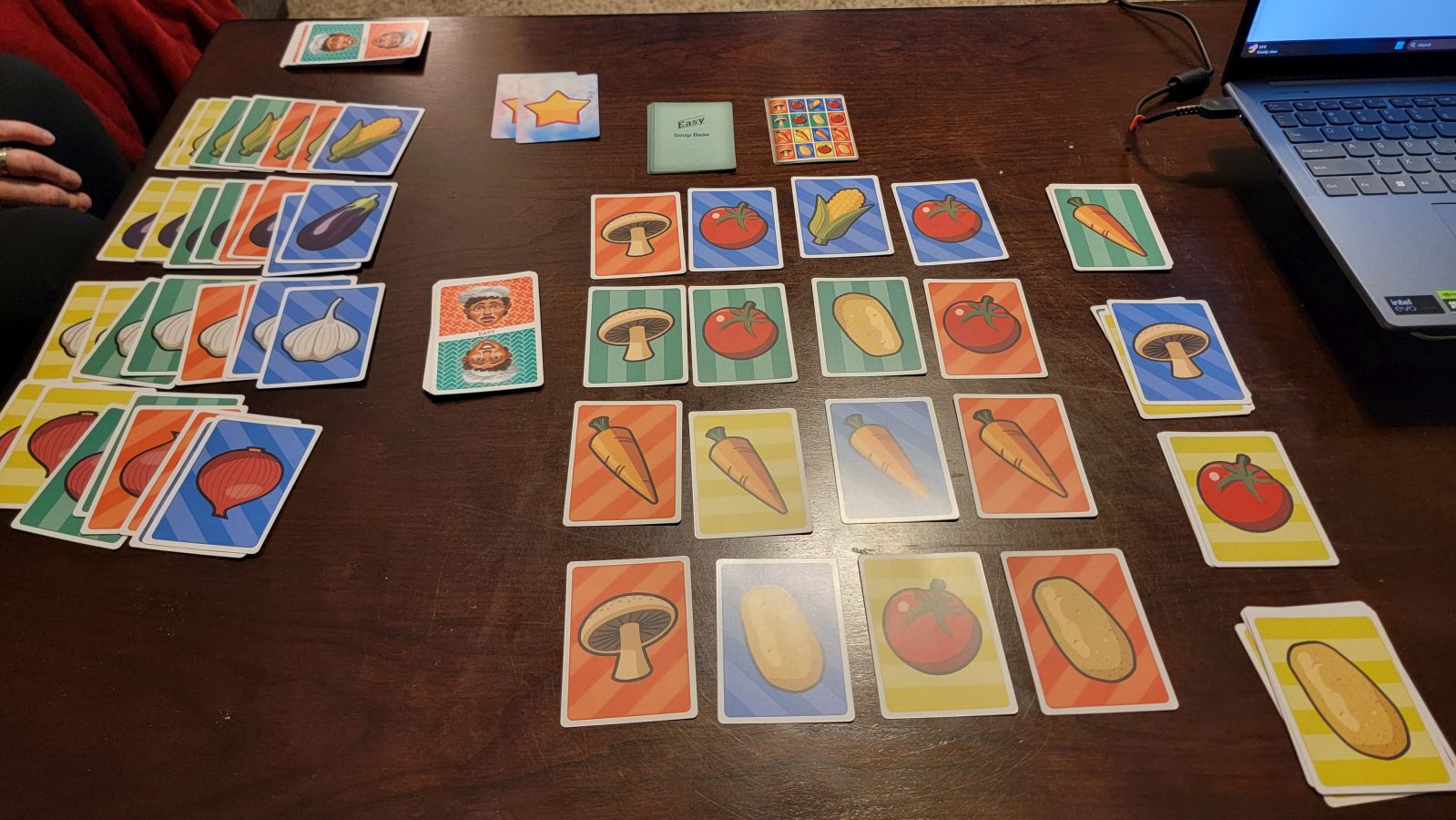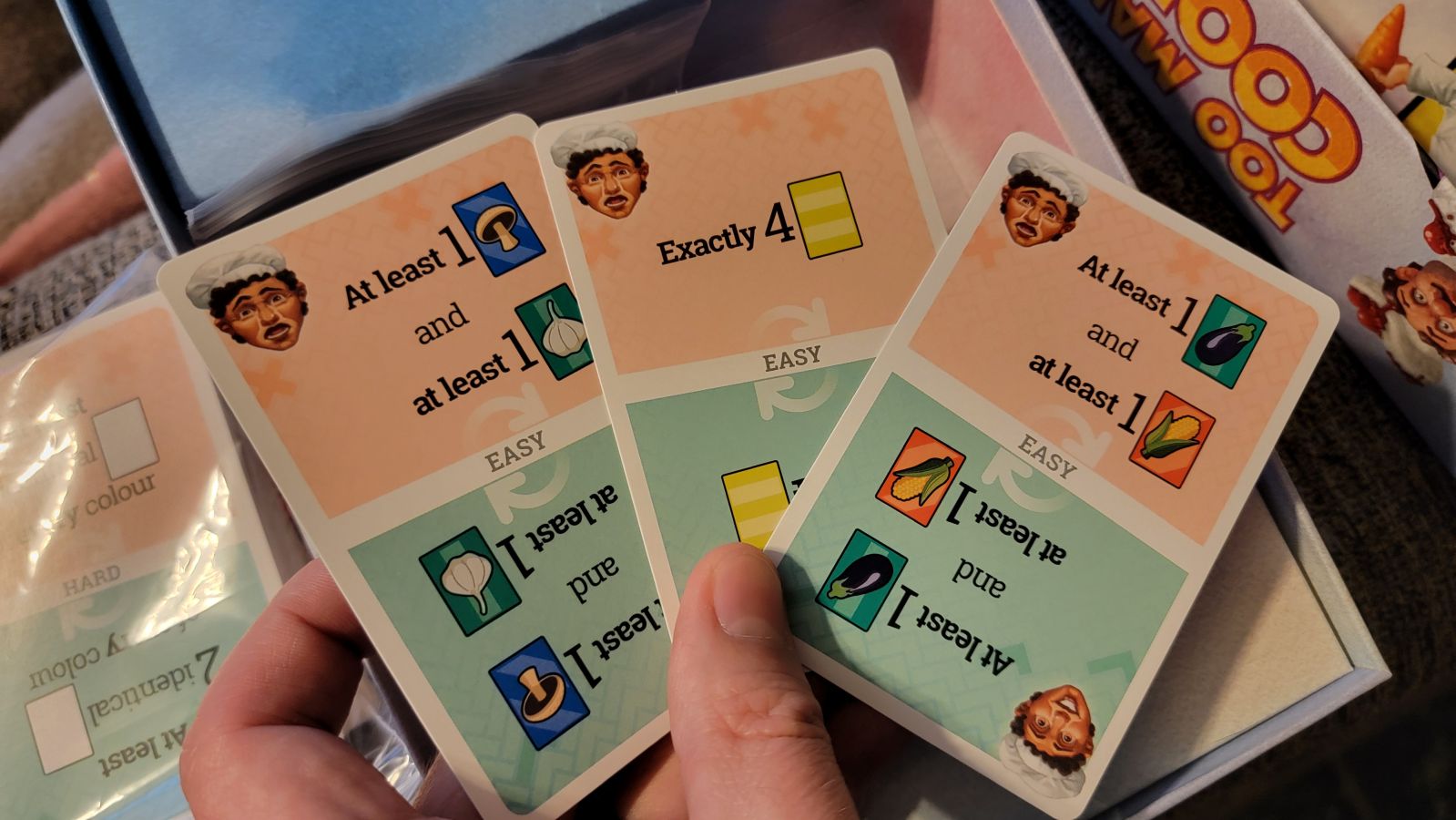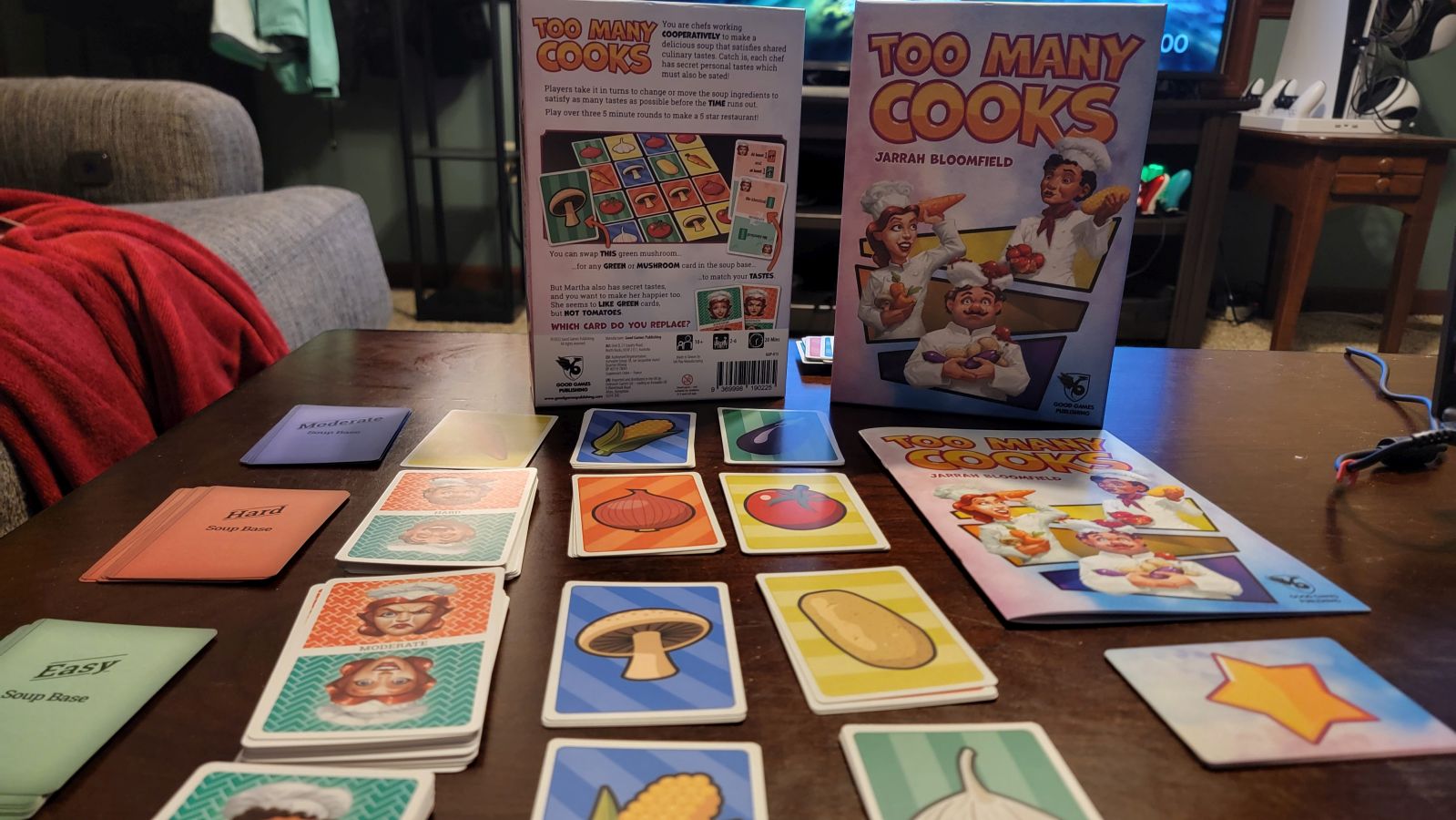Too Many Cooks is a chaotic co-op game played in three short rounds of five minutes each in which players must work together as chefs to create a delicious soup capable of satisfying shared culinary tastes, while also satisfying each chef’s own personal tastes. Despite the simple sounding concept, Too Many Cooks quickly proves to be much deeper than expected, providing an incredibly fun and challenging co-op experience.
Like any good recipe, there are quite a few ingredients required to set this board game up correctly and admittedly, it can be quite confusing the first time you do so. Thankfully, in subsequent games it becomes much easier as you get over the initial learning curve. First things first, find a large table to lay your cards out on. I made a mistake and thought that the coffee table I tend to use for gaming would suffice, but everything was so cramped that it hampered player enjoyment of the game. It wasn’t until we moved to a larger table that we were able to begin to enjoy the experience.
Now that you’ve secured a large table, let’s dive into the box. In the box you’ll find 64 vegetable cards, spread out between eight vegetables, each with four color variations. 60 taste cards, with 20 for each difficulty including easy, moderate, and hard, 18 soup base cards, with six for each difficulty level, and finally five star cards.


You begin by placing two star cards on the table as this will serve as your restaurant’s rating. Your ultimate goal is to reach five stars throughout the three rounds, which is far easier said than done. You must now choose a difficulty and shuffle the corresponding taste cards. I highly recommend beginning at the easy level and working your way up each time you obtain five stars, otherwise you’re in for a rude awakening on just how frantic this game can be. Now you need to lay out all vegetable cards, with the game recommending laying out four vegetables on each side of the table with a four by four card space left in the middle for the soup base. When you lay out the vegetables they need to be splayed, so you can easily see all available colors, and each line of vegetables should be laid out in the same color order.
You will now shuffle the six soup base cards which correspond with your chosen difficulty, before drawing the top card and placing it face up on the table. The image on this card represents the soup base, which will fill the four by four space between your vegetables. Go ahead and pull the vegetables needed to create your soup base and lay them out to match the card’s design. Next you will deal out the taste cards, which are the main crux of the game. During the 1st round seven taste cards are drawn, in the second round you draw nine cards, and in the third round you draw 11 cards. These cards are distributed among players with no more than three going to any player in a two-person game, and no more than two going to a player in a three to six player game. The remaining cards are placed next to the soup base.
The taste cards in your hands are your personal tastes and cannot be shared with other players, while the taste cards laid out on the table are customer taste cards which all players can see. All cards have a happy and unhappy face on the top and bottom on both the player’s side and the outside, allowing other players to know whether your tastes have been satisfied or not at a glance. You begin the game with all taste cards flipped to the unhappy side.

Play begins with a timer set for five minutes. Once the timer starts players will take turns to satisfy the taste requirements on their cards, along with the customer’s cards, while also attempting to not upset the other chef’s tastes. Players are not allowed to specifically state what they like or don’t like, but they can make statements such as “ew” or “mmm” during play to let other players know if a move made satisfies or upsets their tastes. During their turn, a player can either change a card or rotate a row or column. To change a card players can either change the color of the card only, while retaining the vegetable displayed on the card, or change the vegetable on the card, while retaining the original color of the card. To rotate you simply move either the top, bottom, far left, or far right card to the opposite end of the row and then slide all other cards accordingly.
Each taste card has specific taste goals which must be met. This might include having a certain number of a specific color, even amounts of a particular vegetable, not having a specific vegetable in the soup, etc. After five minutes are up all players then go through each of their taste cards and their customer’s taste cards to determine how many taste cards were satisfied. If all taste cards were satisfied then you gain one star to your restaurant rating, if all but one taste is satisfied then your star rating remains the same, if two or more tastes were not satisfied then you lose a star, and if your star rating reaches zero or you have five or more tastes not satisfied then you automatically lose the game. After tallying up your current score you then pull another soup base card, rearrange the soup base accordingly, and set the timer back to five minutes and repeat. After three rounds the game is over. If you manage to have a five-star rating after three rounds, then you can move on to the next difficulty level.
While simple in concept, Too Many Cooks is surprisingly complex once the timer starts counting down. The first time you play you will find yourself in a frantic rush, grabbing and exchanging cards, and very likely making a mess of the board in the process. If you’re anything like my group, at the end of the first round we found we had played the game almost entirely wrong, as we hadn’t realized taste cards not only had specific vegetables on them, but also specific color cards we had to match up. Subsequent games we found ourselves remaining far calmer as we took our turns, and as such we began making progress and watching our star rating rise.
Despite growing more confident in our approach and teamwork, it remained no easy feat to satisfy all tastes on each round and achieve a five star ranking. Even after multiple playthroughs, I’m still not sure if I could make it through the hard difficulty without embarrassing myself. You need to go into a Too Many Cooks playthrough knowing that you’ll fail a few times, but you’ll always understand why you failed and what you could have done differently. This is a testament to the game’s design, as there is always a way to meet all tastes within the required time limit, and the only thing preventing you from doing so is your own mistakes. This is a game I plan to dive back into time and again to hone my skills, hoping to one day reach that coveted five-star rating on the hard difficulty.

Too Many Cooks is a fantastic co-op experience which has players working together as chefs to satisfy unique culinary tastes, often without speaking to each other. While you’re almost certain to fail a few times, you’ll always understand why, helping you inch closer to that coveted five star restaurant rating with each new round. With three difficulty levels, 60 base soup layouts, and an incredibly chaotic gameplay, I can see myself dragging my friends into rounds of Too Many Cooks for years to come.
PROS
- A chaotic and surprisingly difficult co-op experience
- Multiple difficulty levels
- Never becomes frustrating, despite how many times you may fail
CONS
- Requires a large space to set up
Unless otherwise stated, the product in this article was provided for review purposes.
See below for our list of partners and affiliates:

 4 hours ago
22
4 hours ago
22

















